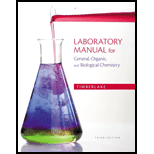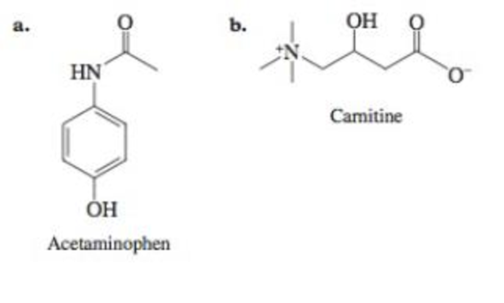
EBK LABORATORY MANUAL FOR GENERAL, ORGA
3rd Edition
ISBN: 9780321918352
Author: Timberlake
Publisher: YUZU
expand_more
expand_more
format_list_bulleted
Concept explainers
Textbook Question
Chapter 4, Problem 4.53AP
Identify all of the functional groups in each of the following molecules:

Expert Solution & Answer
Want to see the full answer?
Check out a sample textbook solution
Students have asked these similar questions
An electrode process takes place at a metal-solution interface. Indicate the current condition that must be met for Faradaic rectification to occur.
At a metal-solution interface, an electron is exchanged, and the symmetry factor beta < 0.5 is found in the Butler-Volmer equation. What does this indicate?
Topic: Photochemistry and Photophysics of Supramolecules
Chapter 4 Solutions
EBK LABORATORY MANUAL FOR GENERAL, ORGA
Ch. 4 - Prob. 4.1PPCh. 4 - Prob. 4.2PPCh. 4 - Prob. 4.3PPCh. 4 - Draw a skeletal structure for ethane, C2H6. Do you...Ch. 4 - Prob. 4.5PPCh. 4 - Prob. 4.6PPCh. 4 - Draw a Lewis structure for each of the following...Ch. 4 - Draw a Lewis structure for each of the following...Ch. 4 - Prob. 4.9PPCh. 4 - Prob. 4.10PP
Ch. 4 - Prob. 4.11PPCh. 4 - Prob. 4.12PPCh. 4 - Write the condensed structure for the...Ch. 4 - Write the condensed structure for the...Ch. 4 - Write the skeletal structure for the alkane shown:...Ch. 4 - Write the skeletal structure for the alkane shown:...Ch. 4 - Identify the family of hydrocarbon present in the...Ch. 4 - Identify the family of hydrocarbon present in the...Ch. 4 - Identify all the functional groups present in the...Ch. 4 - Prob. 4.20PPCh. 4 - The most prevalent fatty acid in coconut oil is...Ch. 4 - The most common fatty acid found in animals is...Ch. 4 - Draw the condensed structural formula for each of...Ch. 4 - Give the correct name for each of the following...Ch. 4 - Draw the skeletal structure for each of the...Ch. 4 - Prob. 4.26PPCh. 4 - Prob. 4.27PPCh. 4 - Prob. 4.28PPCh. 4 - Prob. 4.29PPCh. 4 - Prob. 4.30PPCh. 4 - Determine the relationship between each of the...Ch. 4 - Determine the relationship between each of the...Ch. 4 - Determine if each of the following cycloalkanes or...Ch. 4 - Determine it each of the following cycloalkanes or...Ch. 4 - Mark the chiral centers in the following...Ch. 4 - Mark the chiral centers in the following...Ch. 4 - Convert each of the Lewis structures shown into a...Ch. 4 - Convert each of the Lewis structures in Problem...Ch. 4 - Prob. 4.39APCh. 4 - Prob. 4.40APCh. 4 - Convert the skeletal structures shown to condensed...Ch. 4 - Convert the skeletal structures shown to condensed...Ch. 4 - Prob. 4.43APCh. 4 - Prob. 4.44APCh. 4 - Alkanes are also referred to as saturated...Ch. 4 - Are alkanes considered polar or nonpolar...Ch. 4 - Give the skeletal structure and name of the...Ch. 4 - Give the skeletal structure and name of the...Ch. 4 - Name the following straight-chain alkanes or...Ch. 4 - Name the following straight-chain alkanes or...Ch. 4 - Explain the structural difference between a...Ch. 4 - Prob. 4.52APCh. 4 - Identify all of the functional groups in each of...Ch. 4 - Identify all of the functional groups in each of...Ch. 4 - Prob. 4.55APCh. 4 - Prob. 4.56APCh. 4 - Prob. 4.57APCh. 4 - Draw skeletal structures for each of the following...Ch. 4 - Prob. 4.59APCh. 4 - Prob. 4.60APCh. 4 - Prob. 4.61APCh. 4 - Prob. 4.62APCh. 4 - Prob. 4.63APCh. 4 - Prob. 4.64APCh. 4 - Prob. 4.65APCh. 4 - Prob. 4.66APCh. 4 - How many structural isomers are possible for the...Ch. 4 - Prob. 4.68APCh. 4 - Prob. 4.69APCh. 4 - Prob. 4.70APCh. 4 - For each of the following compounds, indicate...Ch. 4 - Prob. 4.72APCh. 4 - Determine whether each of the following is the cis...Ch. 4 - Determine whether each of the following is the cis...Ch. 4 - Prob. 4.75APCh. 4 - Prob. 4.76APCh. 4 - Mark the chiral centers in the following...Ch. 4 - Mark the chiral centers in the following...Ch. 4 - Prob. 4.79APCh. 4 - Prob. 4.80APCh. 4 - Prob. 4.81CPCh. 4 - Prob. 4.82CPCh. 4 - Prob. 1IA.1QCh. 4 - Prob. 1IA.2QCh. 4 - Prob. 1IA.3QCh. 4 - Prob. 1IA.4QCh. 4 - Prob. 1IA.5QCh. 4 - Prob. 1IA.6QCh. 4 - Prob. 1IA.7QCh. 4 - Prob. 1IA.8QCh. 4 - Prob. 1IA.9QCh. 4 - Prob. 1IA.10QCh. 4 - Prob. 1IA.11QCh. 4 - Prob. 2IA.1QCh. 4 - Prob. 2IA.2QCh. 4 - Prob. 2IA.3QCh. 4 - Prob. 2IA.4QCh. 4 - Prob. 2IA.5QCh. 4 - What is the molecular shape (geometry) of the...Ch. 4 - Prob. 2IA.7QCh. 4 - Prob. 1ICCh. 4 - Prob. 2ICCh. 4 - Prob. 3ICCh. 4 - Prob. 4IC
Knowledge Booster
Learn more about
Need a deep-dive on the concept behind this application? Look no further. Learn more about this topic, chemistry and related others by exploring similar questions and additional content below.Similar questions
- When two solutions, one of 0.1 M KCl (I) and the other of 0.1 M MCl (II), are brought into contact by a membrane. The cation M cannot cross the membrane. At equilibrium, x moles of K+ will have passed from solution (I) to (II). To maintain the neutrality of the two solutions, x moles of Cl- will also have to pass from I to II. Explain this equality: (0.1 - x)/x = (0.1 + x)/(0.1 - x)arrow_forwardCalculate the variation in the potential of the Pt/MnO4-, Mn2+ pair with pH, indicating the value of the standard potential. Data: E0 = 1.12.arrow_forwardGiven the cell: Pt l H2(g) l dis X:KCl (sat) l Hg2Cl2(s) l Hg l Pt. Calculate the emf of the cell as a function of pH.arrow_forward
- The decimolar calomel electrode has a potential of 0.3335 V at 25°C compared to the standard hydrogen electrode. If the standard reduction potential of Hg22+ is 0.7973 V and the solubility product of Hg2Cl2 is 1.2x 10-18, find the activity of the chlorine ion at this electrode.Data: R = 8.314 J K-1 mol-1, F = 96485 C mol-1, T = 298.15 K.arrow_forward2. Add the following group of numbers using the correct number of significant figures for the answer. Show work to earn full credit such as rounding off the answer to the correct number of significant figures. Replace the question marks with the calculated answers or write the calculated answers near the question marks. 10916.345 37.40832 5.4043 3.94 + 0.0426 ? (7 significant figures)arrow_forwardThe emf at 25°C of the cell: Pt l H2(g) l dis X:KCl (sat) l Hg2Cl2(s) l Hg l Pt was 612 mV. When solution X was replaced by normal phosphate buffer solution with a pH of 6.86, the emf was 741 mV. Calculate the pH of solution X.arrow_forward
- Indicate how to calculate the potential E of the reaction Hg2Cl2(s) + 2e ⇄ 2Hg + 2Cl- as a function of the concentration of Cl- ions. Data: the solubility product of Hg2Cl2.arrow_forwardHow can Beer’s Law be used to determine the concentration in a selected food sample. Provide an in-depth discussion and examples of this.arrow_forwardb) H3C- H3C Me CH 3 I HN Me H+arrow_forward
arrow_back_ios
SEE MORE QUESTIONS
arrow_forward_ios
Recommended textbooks for you
 Introductory Chemistry: An Active Learning Approa...ChemistryISBN:9781305079250Author:Mark S. Cracolice, Ed PetersPublisher:Cengage Learning
Introductory Chemistry: An Active Learning Approa...ChemistryISBN:9781305079250Author:Mark S. Cracolice, Ed PetersPublisher:Cengage Learning Introductory Chemistry: A FoundationChemistryISBN:9781337399425Author:Steven S. Zumdahl, Donald J. DeCostePublisher:Cengage Learning
Introductory Chemistry: A FoundationChemistryISBN:9781337399425Author:Steven S. Zumdahl, Donald J. DeCostePublisher:Cengage Learning Living By Chemistry: First Edition TextbookChemistryISBN:9781559539418Author:Angelica StacyPublisher:MAC HIGHER
Living By Chemistry: First Edition TextbookChemistryISBN:9781559539418Author:Angelica StacyPublisher:MAC HIGHER Chemistry: The Molecular ScienceChemistryISBN:9781285199047Author:John W. Moore, Conrad L. StanitskiPublisher:Cengage Learning
Chemistry: The Molecular ScienceChemistryISBN:9781285199047Author:John W. Moore, Conrad L. StanitskiPublisher:Cengage Learning Chemistry for Today: General, Organic, and Bioche...ChemistryISBN:9781305960060Author:Spencer L. Seager, Michael R. Slabaugh, Maren S. HansenPublisher:Cengage LearningChemistry: Matter and ChangeChemistryISBN:9780078746376Author:Dinah Zike, Laurel Dingrando, Nicholas Hainen, Cheryl WistromPublisher:Glencoe/McGraw-Hill School Pub Co
Chemistry for Today: General, Organic, and Bioche...ChemistryISBN:9781305960060Author:Spencer L. Seager, Michael R. Slabaugh, Maren S. HansenPublisher:Cengage LearningChemistry: Matter and ChangeChemistryISBN:9780078746376Author:Dinah Zike, Laurel Dingrando, Nicholas Hainen, Cheryl WistromPublisher:Glencoe/McGraw-Hill School Pub Co

Introductory Chemistry: An Active Learning Approa...
Chemistry
ISBN:9781305079250
Author:Mark S. Cracolice, Ed Peters
Publisher:Cengage Learning

Introductory Chemistry: A Foundation
Chemistry
ISBN:9781337399425
Author:Steven S. Zumdahl, Donald J. DeCoste
Publisher:Cengage Learning

Living By Chemistry: First Edition Textbook
Chemistry
ISBN:9781559539418
Author:Angelica Stacy
Publisher:MAC HIGHER

Chemistry: The Molecular Science
Chemistry
ISBN:9781285199047
Author:John W. Moore, Conrad L. Stanitski
Publisher:Cengage Learning

Chemistry for Today: General, Organic, and Bioche...
Chemistry
ISBN:9781305960060
Author:Spencer L. Seager, Michael R. Slabaugh, Maren S. Hansen
Publisher:Cengage Learning

Chemistry: Matter and Change
Chemistry
ISBN:9780078746376
Author:Dinah Zike, Laurel Dingrando, Nicholas Hainen, Cheryl Wistrom
Publisher:Glencoe/McGraw-Hill School Pub Co
Lipids - Fatty Acids, Triglycerides, Phospholipids, Terpenes, Waxes, Eicosanoids; Author: The Organic Chemistry Tutor;https://www.youtube.com/watch?v=7dmoH5dAvpY;License: Standard YouTube License, CC-BY